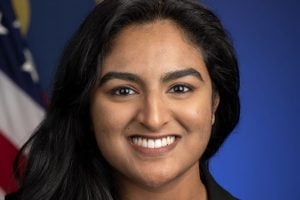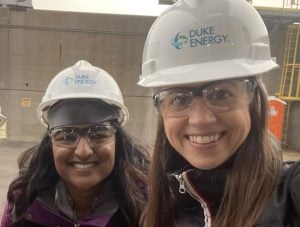
Trifeena James, ENGR’22, ‘24 (MSE), is a NASA engineer working at Virginia-based Coherent Applications, Inc., a specialized firm that develops advanced laser and LiDAR systems for aerospace and defense clients.
Here, James—a native of the Dallas-Fort Worth area—discusses her career path, from earning her undergraduate and graduate degrees at Johns Hopkins to working on cutting-edge aerospace technology development.
Tell us about your experience at Hopkins.
I conducted work with Mark Shelhamer’s Human Spaceflight lab, looking at the physiological interactions of the human body while in outer space. Journal clubs were particularly fun because it was open to industry and academic peers, allowing for rich discussions and multi-disciplinary perspectives.
I focused my MSE coursework on manufacturing methodologies because I wanted to be informed as an early professional on what manufacturing technologies were available to turn a nebulous idea into a tangible object. In industry, this field of knowledge is called Design for Manufacturing, and that’s what I oriented my MSE toward.
Being at Hopkins, I got to experience a variety of research environments, like the opportunity to participate in a multi-disciplinary Classics Research Lab led by Emily Anderson, an associate professor of classics at the Krieger School. In learning to collaborate during the COVID-19 pandemic, I have a lot of fond memories working with my lab mates and getting excited over discoveries as we scoured through archival material.

James, left, visits Markland Dam on the Ohio River near Cincinnati while working as a TA for the Multidisciplinary Design course instructed by Alissa Burkholder Murphy, right.
How did the MSE program prepare you for the career you are in now?
While I was in the MSE program, I was also working remotely as a graduate researcher at NASA Langley Research Center. The flexibility of the MSE program allowed me to not only balance my coursework while conducting research at NASA but also to closely intertwine my studies with the work I was doing every day. There were several moments where I was applying concepts from work in my coursework and vice versa. With the MSE program, I was able to take Space Systems Engineering classes from the Engineering Professionals (EP) Program. These supplemental classes to my Mechanical Engineering coursework resulted in a great mix of theoretical- and application-based material.
Tell us about your job now.
I now work as a Human Systems Integration Engineer and Design Facilitator. My job involves conducting human-centered design and human factors for projects such as full-scale impact testing for a lunar lander and heat shield development. I also design and execute facilitated workshops for our design lab, supporting project brainstorming, technology advancement, and business strategic planning.